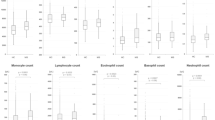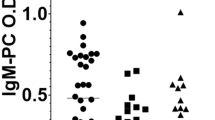Abstract
Organisms adjust the order, or fluidity, of their cellular membranes in response to changes in their physiochemical environment by adjusting the lipid composition of their membranes. We investigated membrane fluidity using the phospholipid, fatty acid and cholesterol content of red blood cells (RBCs) from multiple sclerosis (MS) patients and correlated this with C-reactive protein (CRP) as well as with the severity of neurological outcome as measured by the Kurtzke Expanded Disability Status Scale (EDSS) and its Functional System Scores. The study group consisted of 31 patients with MS and 30 healthy control subjects. Phospholipids were determined using a colorimetric assay, fatty acids by gas chromatography, cholesterol by an enzymatic assay and CRP by a Beckman nephelometer. Cell membrane fluidity was calculated according to previously established formulae. RBC membrane fluidity as measured by the saturated to polyunsaturated fatty acid ratio was higher in patients than in controls (P = 0.04). The phosphatidylethanolamine saturated to polyunsaturated fatty acid ratio showed highly significant positive correlations with the EDSS and CRP < 5 μg/ml. CRP showed significant inverse correlations with the saturated nature but positive correlations with the ordered-crystalline-phase to liquid-crystalline-phase lipid ratio. In this study we show that membrane fluidity as measured by the relationship between membrane fatty acids, phospholipids and cholesterol is closely interrelated with inflammation and disease outcome in patients with MS. In conclusion, our findings suggest that the membrane lipid composition of patients with MS and, consequently, membrane fluidity are altered, which seems to be influenced by the inflammatory status.

Similar content being viewed by others
References
Allen JE, Rasmussen H (1971) Human red blood cells: prostaglandin E2, epinephrine, and isoproterenol alter deformability. Science 174:512–514
Allen HG, Allen JC, Boyd LC, Alston-Mills BP, Fenner GP (2006) Determination of membrane lipid differences in insulin resistant diabetes mellitus type 2 in whites and blacks. Nutrition 22:1096–1102
Barenholz Y (2002) Cholesterol and other membrane active sterols: from membrane evolution to “rafts”. Prog Lipid Res 41:1–5
Barenholz Y, Thompson TE (1999) Sphingomyelin: biophysical aspects. Chem Phys Lipids 102:29–34
Boggs JM, Moscarello MA (1980) A comparison of composition and fluidity of multiple sclerosis and normal myelin. Neurochem Res 5:319–336
Brück W (2005) Clinical implications of neuropathological findings in multiple sclerosis. J Neurol 252:III/10–III/14
Caret RL, Denniston KJ, Topping JJ (1997) Lipids and their functions in biochemical systems. In: Wheatley CH (ed) Principles and applications of inorganic, organic and biological chemistry. McGraw-Hill, Boston, pp 379–407
Cheravil GD (1984) Sialic acid and fatty acid concentrations in lymphocytes, red blood cells and from patients with multiple sclerosis. J Neurol Sci 63:1–10
Chia LS, Thompson JE, Moscarello MA (1984) Alteration of lipid-phase behavior in multiple sclerosis myelin revealed by wide-angle X-ray diffraction. Proc Natl Acad Sci USA 81:1871–1874
Folch J, Lees M, Sloane-Stanley GH (1957) A simple method for the isolation and purification of total lipids from animal tissues. J Biol Chem 226:497–509
Giovannoni G, Thorpe JW, Kidd D, Kendall BE, Moseley IF, Thompson AJ, Keir G, Miller DH, Feldmann M, Thompson EJ (1996) Soluble E-selectin in multiple sclerosis: raised concentrations in patients with primary progressive disease. J Neurol Neurosurg Psychiatry 60:20–26
Giovannoni G, Miller DH, Losseff NA, Sailer M, Lewellyn-Smith N, Thompson AJ, Thompson EJ (2001) Serum inflammatory markers and clinical/MRI markers of disease progression in multiple sclerosis. J Neurol 248:487–495
Göpfert E, Pytlik S, Debuch H (1980) 2′,3′-Cyclic nucleotide 3′-phosphohydrolase and lipids of myelin from multiple sclerosis and normal brains. J Neurochem 34:732–739
Hamai C, Yang T, Kataoka S, Cremer PS, Musser SM (2006) Effect of average phospholipid curvature on supported bilayer formation on glass by vesicle fusion. Biophys J 90:1241–1248
Harbige LS, Sharief MK (2007) Polyunsaturated fatty acids in the pathogenesis and treatment of multiple sclerosis. Br J Nutr 98:S46–S53
Harlos K, Eibl H (1981) Hexagonal phases in phospholipids with saturated chains: phosphatidylethanolamines and phosphatidic acids. Biochemistry 20:2888–2892
Harris FM, Smith SK, Bell JD (2001) Physical properties of erythrocyte ghosts that determine susceptibility to secretory phospholipase A2. J Biol Chem 276:22722–22731
Hazel JR, Williams EE (1990) The role of alterations in membrane lipid composition in enabling physiological adaptation of organisms to their physical environment. Prog Lipid Res 29:167–227
Holman RT, Johnson SB, Kokmen E (1989) Deficiencies of polyunsaturated fatty acids and replacement by nonessential fatty acids in plasma lipids in multiple sclerosis. Proc Natl Acad Sci USA 86:4720–4724
Hon GM, Hassan MS, Van Rensburg SJ, Abel S, De Marais W, Van Jaarsveld P, Smuts CM, Henning F, Erasmus RT, Matsha T (2009a) Erythrocyte membrane fatty acids in patients with multiple sclerosis. Mult Scler 15:759–762
Hon GM, Hassan MS, Van Rensburg SJ, Abel S, De Marais W, Van Jaarsveld P, Smuts CM, Henning F, Erasmus RT, Matsha T (2009b) Immune cell membrane fatty acids and inflammatory marker, C-reactive protein in patients with multiple sclerosis. Br J Nutr 19:1–7
Hon GM, Hassan MS, Van Rensburg SJ, Abel S, Erasmus RT Matsha T (2009c) Membrane saturated fatty acids and disease progression in multiple sclerosis patients. Metab Brain Dis (in press)
Horrobin DF (1999) The phospholipid concept of psychiatric disorders and its relationship to the neurodevelopmental concept of schizophrenia. In: Peet M, Glen I, Horrobin DF (eds) Phospholipid spectrum disorder in psychiatry. Marius Press, Carnforth, UK, pp 3–16
Itaya K, Ui M (1966) A new micromethod for the colorimetric determination of inorganic phosphate. Clin Chim Acta 14:361–366
Koay ESC, Walmsley N (1999) Plasma lipids and lipoproteins. In: Koay ESC, Walmsley N (eds) A primer of chemical pathology. World Scientific, Singapore, pp 191–211
Kurantsin-Mills J, Samji N, Moscarello MA, Boggs JM (1982) Comparison of membrane structure, osmotic fragility, and morphology of multiple sclerosis and normal erythrocytes. Neurochem Res 7:1523–1540
Kurtzke JF (1983) Rating neurologic impairment in multiple sclerosis: an Expanded Disability Status Scale (EDSS). Neurology 33:1444–1452
Labrouche S, Freyburger G, Gin H, Boisseau MR, Cassagne C (1996) Changes in phospholipid composition of blood cell membranes (erythrocyte, platelet, and polymorphonuclear) in different types of diabetes—clinical and biological correlations. Metabolism 45:57–71
Manzoli FA, Stefoni S, Manzoli-Guidotti L, Barbieri M (1970) The fatty acids of myelin phospholipids. FEBS Lett 10:317–320
Navarro X, Segura R (1989) Red blood cell fatty acids in multiple sclerosis. Acta Neurol Scand 79:32–37
Nightingale S, Woo E, Smith AD, French JM, Gale MM, Sinclair HM, Bates D, Shaw DA (1990) Red blood cell and adipose tissue fatty acids in mild inactive multiple sclerosis. Acta Neurol Scand 82:43–50
Ohler B, Graf K, Bragg R, Lemons T, Coe R, Genain C, Israelachvili J, Husted C (2004) Role of lipid interactions in autoimmune demyelination. Biochim Biophys Acta 1688:10–17
Pollock S, Harrison MJ, O’Connell G (1982) Erythrocyte deformability in multiple sclerosis. J Neurol Neurosurg Psychiatry 45:762
Richmond W (1973) Preparation and properties of a cholesterol oxidase from Nocardia sp. and its application to the enzymatic assay of total cholesterol in serum. Clin Chem 19:1350–1356
Sellner J, Greeve I, Mattle HP (2008) Atorvastatin decreases high-sensitivity C-reactive protein in multiple sclerosis. Mult Scler 14:981–984
Smuts CM, Weich HFH, Weight MJ, Faber M, Kruger M, Lombard CJ, Benade AJS (1994) Free cholesterol concentrations in the high-density lipoprotein subfraction-3 as a risk indicator in patients with angiographically documented coronary artery disease. Coron Artery Dis 5:331–338
Van Jaarsveld PJ, Smuts CM, Tichelaar HY, Kruger M, Benadé AJS (2000) Effect of palm oil on plasma lipoprotein concentrations and plasma low-density lipoprotein composition in non-human primates. Int J Food Sci Nutr 51:S21–S30
Van Meeteren ME, Teunissen CE, Dijkstra CD, Van Tol EA (2005) Antioxidants and polyunsaturated fatty acids in multiple sclerosis. Eur J Clin Nutr 59:1347–1361
Voet D, Voet JG (1995) Lipids and membranes. In: Voet D, Voet JG (eds) Biochemistry. Wiley, New York, pp 277–329
Williams EE (1998) Membrane lipids: what membrane physical properties are conserved during physiochemically-induced membrane restructuring? Am Zool 38:280–290
Wilson R, Tocher DR (1991) Lipid and fatty acid composition is altered in plaque tissue from multiple sclerosis brain compared with normal brain white matter. Lipids 26:9–15
Zamaria N (2004) Alteration of polyunsaturated fatty acid status and metabolism in health and disease. Reprod Nutr Dev 44:273–282
Acknowledgement
We extend our sincere gratitude to the following: MS Society, Western Cape Branch, South Africa, and Sister Treska Botha for the recruitment of patients; Ms. Johanna van Wyk for technical support in the analysis of fatty acids; Dr. Marius de Klerk for the measurement of the EDSS and FSS. This study was funded by a grant from the University Research Fund of the Cape Peninsula University of Technology, South Africa.
Author information
Authors and Affiliations
Corresponding author
Rights and permissions
About this article
Cite this article
Hon, G.M., Hassan, M.S., van Rensburg, S.J. et al. Red Blood Cell Membrane Fluidity in the Etiology of Multiple Sclerosis. J Membrane Biol 232, 25–34 (2009). https://doi.org/10.1007/s00232-009-9213-1
Received:
Accepted:
Published:
Issue Date:
DOI: https://doi.org/10.1007/s00232-009-9213-1




